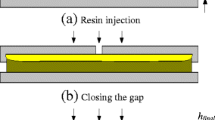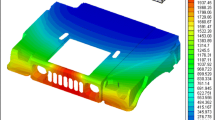Abstract
The mold filling of RTM was simulated based on the control volume finite element method (CV/FEM). The formulation using isoparametric transformation was discussed in detail and a computational code based on isoparametric technique was developed. The simulation results were compared with experimental data. Different isoparametric elements, quadrilateral and triangular, were compared in the simulation. It demonstrates that the use of bilinear quadrilateral isoparametric elements in simulating the process can produce a higher precision and cost a less time than the use of triangular ones.
Similar content being viewed by others

References
T Richardson.Composites, A Design Guide. New York: Industrial Press Inc, 1987
Kevin Potter.Resin Transfer Molding. New York: Chapman & Hall Press, 1997
Raymond Gauvin, Francois Trochu. Key Issues in Numerical Simulation for Liquid Composite Molding Process.Polymer Composites, 1998, 19: 233–239
Li S, Gauvin R. Numerical Analysis of the Resin Flow in Resin Transfer Molding.Journal of Reinforced Plastics and Composites, 1991, 10: 314–327
Ayogi H, Uenoyama M, Guceri S I. Analysis and Simulation of Structural Reaction Injection Molding (SRIM).International Polymer Processing, 1992, 7: 71–83
Bruno A, Molina G, Betracchi G, Moroni A. Flow Behavior in RTM: Numerical Simulation.Advanced Composite Materials: New Developments and Applications Conference Proceedings, 1991: 217–223
F M Schmidt, P Lafleur, P Berthet, P Devos. Numerical Simulation of Resin Transfer Molding Using Linear Boundary Element Method.Polymer Composites, 1999, 20: 725–732
W B Young, K Han, L H Fong, L James Lee. Flow Simulation in Molds with Preplaced Fiber Mats.Polymer Composites, 1991, 12: 391–403
Bruschke M V, Advani S G. A Finite Element/Control Volume Approach to Mold Filling in Anisotropic Porous Media.Polymer Composites, 1990, 11: 398–405
Lin R, Lee L J, Liou M. Non-isothermal Mold Filling Curing Simulation in Thin Cavities with Preplaced Fiber Mats.International Polymer Processing VI, 1991, 4: 356–369
R J Lin, L James Lee, Ming J Liu. Mold Filling and Curing Analysis in Liquid Composite Molding.Polymer Composites, 1993, 14: 71–81
O C Zienkiewicz, R L Taylor.The Finite Element Method, New York: McGraw-hill Book Company, 1989
Simon Bickton, Advani SG. Experimental Investigation and Flow Visualization of the Resin-transfer Mold Filling Process in a Non-planar Geometry.Composites Science and Technology, 1997, 57: 23–33
Moon Koo Kang, Jae Joon Jung, Woo II Lee. Analysis of Resin Transfer Moulding Process with Controlled Multiple Gates Resin Injection.Composites: Part A, 2000, 31: 407–422
Author information
Authors and Affiliations
Corresponding author
Additional information
Funded by the National Natural Science Foundation of China (19872051) and the National “863” H-tech Foundation (2001AA335020)
Rights and permissions
About this article
Cite this article
Kaipeng, Z., Hua, T., Jihui, W. et al. Numerical simulation of mold filling in resin transfer molding using isoparametric method. J. Wuhan Univ. Technol.-Mat. Sci. Edit. 20, 98–101 (2005). https://doi.org/10.1007/BF02870885
Received:
Accepted:
Issue Date:
DOI: https://doi.org/10.1007/BF02870885



